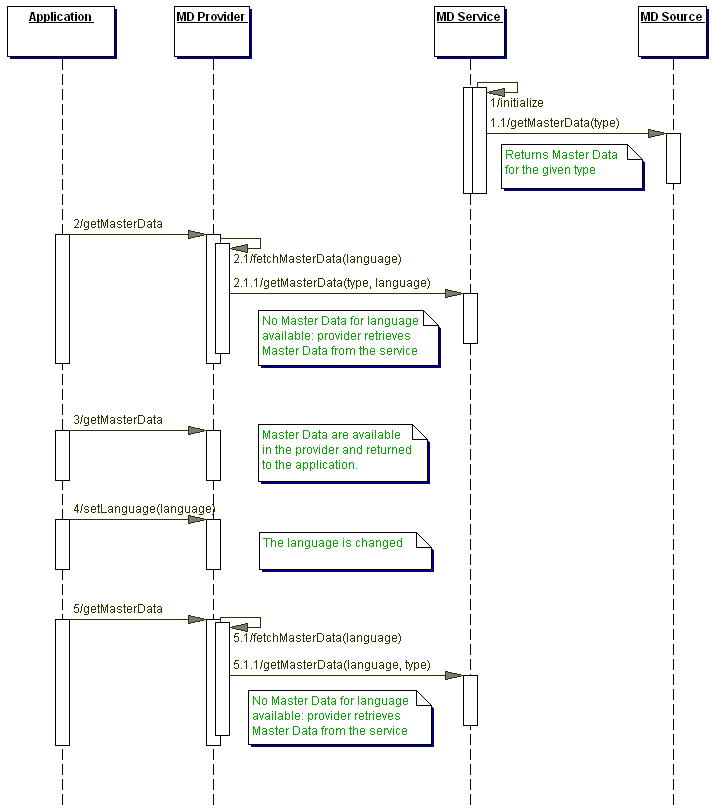The Master Data Management pattern describes a generic solution for the problem of language-dependent information within a domain model.
In relational databases master data are often held in special look-up tables, which are joined together when a domain model is built up from a database. In many cases these language-dependent data are provided to the object model as integral part ot it. Dynamic switching the language at runtime requires a difficulat transaction to replace these language-dependent parts with new textual descriptions for the new language. Potentially the whole domain model has to be updated with the database and reloaded.
The Master Data Management pattern no describes a solution, which can enable your application to switch the language dynamically without difficult database transactions.
See the Download Section for a reference implementation and the source of the example.
Base Data, language dependent data, (German: Stammdaten)
The figure illustrates the proposed solution for dynamic language switching: The domain model only refers to the Master Data objects by their object ID, which in many cases may be simply the foreign key to the relational database table for the Master Data. The Master Data Provider acts as broker for the required language-dependent data: It retrieves and manages them from the system and provides the matching Master Data object for the required type, ID and language.

Figure 1: Connecting domain objects to Master Data
For Example: In an application from the Automotive sector a Vehicle object is edited. It holds several data like a licence plate, chassis number, power data, which are language independent, and language dependent information as e.g. the Paint. To be able to switch the client language while the Vehicle is edited, the Paint object is made a language dependent Master Data object. The Vehicle object just holds the paintId of the assigned Paint object, the application requests a Paint object for this ID and the current language from the Master Data Provider at runtime e.g. to display the paint color of the Vehicle at runtime or allow the user to select a Paint from a list.

Figure 2: Example: Vehicle and Paint Master Data
The responsibility for Master Data Management is distributed into three tiers:

Figure 3: Strucuture of the Master Data pattern
The following sequence diagram illustrates a simple example for the collaboration of the different participants of the Master Data Management.

Figure 4: Master Data sequence diagram
The diagrams displays five sequential processing steps:
The following class diagram illustrates the structure of the reference implementation. For all required participants in the Master Data Management an interface and at least one default implementation is provided.

Figure 5: Master Data class diagram
Master Data:
public class Paint extends LDMasterData {
/** Field color (Color) is used to identify the Color value of the Master Data object */
private Color color;
/**
* Constructor
*/
public Paint(String id, String language, String text, Color color) {
super(id, language, text);
setColor(color);
}
}
public class MyMasterDataProvider extends DefaultMasterDataProvider {
/**
* Constructor
*/
public MyMasterDataProvider() {
super();
setService(new MyMasterDataService());
}
/**
* Insert the method's description here.
*/
public Paint getPaint(String id) {
return (Paint) getMasterData("Paint", id);
}
/**
* Insert the method's description here.
*/
public Vector getPaints() {
return getMasterData("Paint");
}
}
public class MyMasterDataService extends DefaultMasterDataService {
/**
* Initialize the Master Data cache
* This subclass is a simple exampe how master data can be initialized.
*/
public void initialize() {
super.initialize();
addMasterDataContainer("Paint", new PaintDataSource().getMasterData("Paint"));
...
}
}
public class PaintDataSource implements IMasterDataSource {
/**
* Provide some instances of Paint as simple example
*/
public IMasterDataContainer getMasterData(String type) {
Vector v = new Vector();
v.addElement(new Paint("ff0000", "de" , "rot", Color.red));
v.addElement(new Paint("00ff00", "de" , "grün", Color.green));
v.addElement(new Paint("0000ff", "de" , "blau", Color.blue));
v.addElement(new Paint("000000", "de" , "schwarz", Color.black));
v.addElement(new Paint("ffffff", "de" , "weiß", Color.white));
v.addElement(new Paint("7f7f7f", "de" , "grau", Color.gray));
v.addElement(new Paint("ff0000", "en" , "red", Color.red));
v.addElement(new Paint("00ff00", "en" , "green", Color.green));
v.addElement(new Paint("0000ff", "en" , "blue", Color.blue));
v.addElement(new Paint("000000", "en" , "black", Color.black));
v.addElement(new Paint("ffffff", "en" , "white", Color.white));
v.addElement(new Paint("7f7f7f", "en" , "gray", Color.gray));
v.addElement(new Paint("ff0000", "fr" , "rouge", Color.red));
v.addElement(new Paint("00ff00", "fr" , "vert", Color.green));
v.addElement(new Paint("0000ff", "fr" , "bleue", Color.blue));
v.addElement(new Paint("000000", "fr" , "noir", Color.black));
v.addElement(new Paint("ffffff", "fr" , "blanc", Color.white));
v.addElement(new Paint("7f7f7f", "fr" , "gris", Color.gray));
return new LDMasterDataContainer(v);
}
}
A similar implementation was elaborated to manage Master Data in a distributed used car management system.
None.
Download the reference implementation and the source of the example here!
The package openfuture.masterdata and all its sub-packages and extensions is free software; you can redistribute it and/or modify it under the terms of the GNU Lesser General Public License as published by the Free Software Foundation; either version 2 of the License, or (at your option) any later version.
This library is distributed in the hope that it will be useful, but WITHOUT ANY WARRANTY; without even the implied warranty of MERCHANTABILITY or FITNESS FOR A PARTICULAR PURPOSE. See the GNU Lesser General Public License for more details.
You should have received a copy of the GNU Lesser General Public License along with this library; if not, write to the
Free Software Foundation, Inc.,
59 Temple Place,
Suite 330, Boston,
MA 02111-1307
USA
Or visit http://www.gnu.org/copyleft/lesser.html.
0.1 |
Creation |
|
1.0 |
First release of the component |
|
1.2 |
"History tag in package description added |
|
1.3 |
Resource Bundle MD Source and Localized MD Container added |